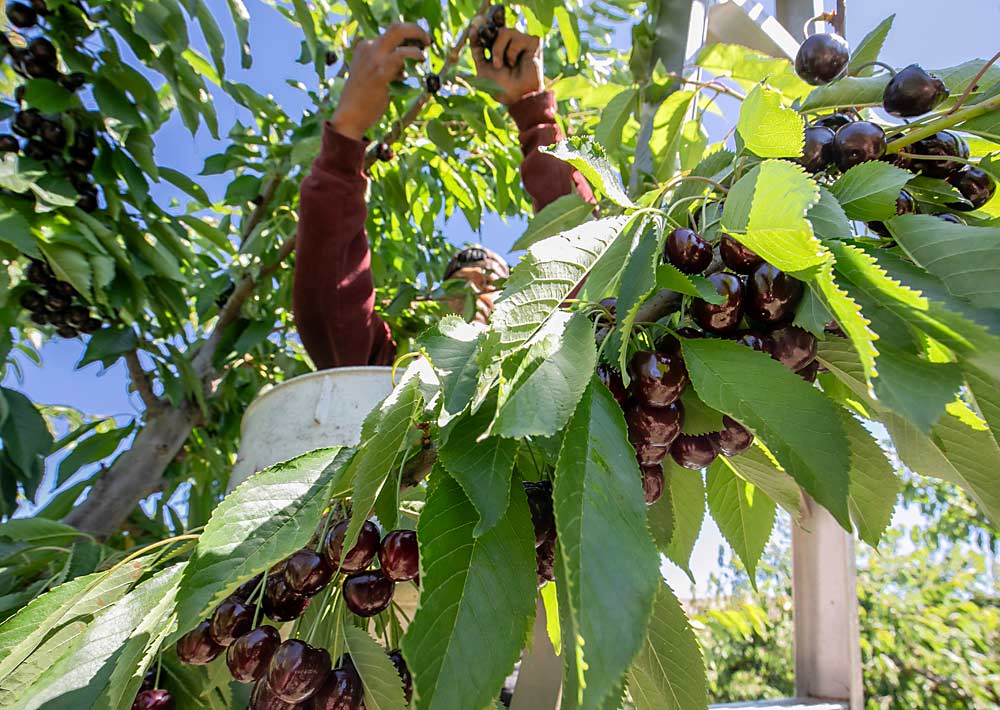
The Pacific Northwest’s 2023 sweet cherry crop was a loss for many growers.
But was it a disaster?
Industry organizations think so, and they are citing the unusual spring weather conditions that resulted in overlapping bloom and a narrow harvest window up and down the West Coast in their petitions for disaster designations that could open the door to federal financial assistance.
About 70 percent of U.S. cherries matured in a one-month stretch — from mid-June to mid-July — instead of the usual span of three months. This exceeded the capacity of the supply chain and the market, creating “a weather-driven market failure,” according to a letter industry leaders sent to the director of the Washington State Department of Agriculture late last year, requesting that Gov. Jay Inslee declare a disaster.
Oregon growers made a similar request at the end of the season.
There was no formal response to the requests by Good Fruit Grower’s print deadline in early December.
Typically, disaster designations reflect crop loss due to natural disasters such as wildfires, storms or drought. While the recent cherry season doesn’t exactly fit that scenario, proponents say the challenges were equally climate-driven.
“It’s all tied to climate. Because of climate, the market got flooded when our cherries traditionally come on,” said Mike Doke, executive director of Columbia Gorge Fruit Growers. “Only about 60 percent of the crop was harvested.”
Norm Gutzwiler, a Wenatchee-area grower and Washington State Fruit Commission board member, said he walked away from his entire crop.
“This was nothing (but) a bad rainstorm, but with no water. We lost the crop,” he said. “We have to be able to put a quality product on the market for the consumer, and they couldn’t get all the fruit moved quick enough. We can’t do much about the fact that it was a condensed season, that’s just Mother Nature.”
Many Northwest growers point at the California crop, which came in at 10 million 18-pound boxes (double the 2022 harvest) and stretched into the traditional Northwest market after a long, cold spring delayed California’s season.
In 2022, when there was a gap between the smaller California and Northwest crops, the price per pound held around $4.50 for 10-row cherries in late June, according to an analysis of U.S. Department of Agriculture data by Oregon State University economist Tim Delbridge. In 2023, in contrast, the glut of California cherries forced shippers to drop prices in June to below $2.00 per pound, and that’s the price at which Northwest fruit entered the market.
“Everything was flooded, and what do we do when that happens? We all drop the price,” said Javier Sanchez, director of sales and marketing for Northern Fruit Co. and also a WSFC board member. “Once the market is there, it’s hard to bring it back up.”
More communication with California shippers and across the Northwest industry could possibly help mitigate the “race-to-the-bottom” pricing that occurs when the market is flooded, Sanchez said.
Stacey Cooper, a grower in The Dalles, Oregon, agreed.
“It comes down to the fact that we have a perishable crop, and when (it) hits the fan we all undercut each other to move the fruit, and then buyers keep the price high so fruit doesn’t move,” she said. “My feeling is we’ve got to find common ground to get a large crop sold.”
She left probably half of the crop on the trees, she said.
A lot of blocks went unpicked in the Yakima Valley as well, especially some midseason varieties that overset, said Peter Verbrugge, general manager of Pacific Coast Cherry Packers and also a WSFC board member.
“That led to smaller fruit that, given the volume of fruit available, was undesirable and unsellable,” he said. “So, at our company, we told growers to stop (picking) in many cases when we didn’t think they would get the cost of harvest back. People were pretty upset but now, as things have shaken out, I think they understand that we were trying to keep them from losing more money.”
Forgoing harvest when cherry prices won’t cover the cost of picking is the only option, Gutzwiler said.
“You have to be able to say, ‘No, I’m sorry, I don’t have a job for the pickers or fruit for the warehouse, I am not going to lose any more money,’” he said. “We as growers need to have sharp pencils and make those decisions quickly.”
As for the overlap with California, he thinks the Northwest cherry industry may have to adapt as both regions try to extend their seasons.
“California’s doing the same thing we are doing, but in reverse. The fact is we are going to have these crossovers on a regular basis,” he said.
The focus, Sanchez, Cooper and Gutzwiler all said, needs to be on producing top-quality cherries that drive demand and also on keeping lower-quality fruit out of the market — easier said than done in lean times.
Looking ahead to the 2024 crop, Verbrugge said he’s worried about growers who can’t repay and renew their operating lines of credit.
“That limits their ability to farm properly and put the inputs into farming a higher-quality crop,” he said.
Northwest cherry growers will gather to discuss their challenges and opportunities at the Cherry Institute on Jan. 12 in Yakima. For more information, visit: nwcherries.com.
—by Kate Prengaman






Leave A Comment